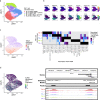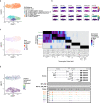The chromatin landscape of pathogenic transcriptional cell states in rheumatoid arthritis
- PMID: 38821936
- PMCID: PMC11143375
- DOI: 10.1038/s41467-024-48620-7
The chromatin landscape of pathogenic transcriptional cell states in rheumatoid arthritis
Abstract
Synovial tissue inflammation is a hallmark of rheumatoid arthritis (RA). Recent work has identified prominent pathogenic cell states in inflamed RA synovial tissue, such as T peripheral helper cells; however, the epigenetic regulation of these states has yet to be defined. Here, we examine genome-wide open chromatin at single-cell resolution in 30 synovial tissue samples, including 12 samples with transcriptional data in multimodal experiments. We identify 24 chromatin classes and predict their associated transcription factors, including a CD8 + GZMK+ class associated with EOMES and a lining fibroblast class associated with AP-1. By integrating with an RA tissue transcriptional atlas, we propose that these chromatin classes represent 'superstates' corresponding to multiple transcriptional cell states. Finally, we demonstrate the utility of this RA tissue chromatin atlas through the associations between disease phenotypes and chromatin class abundance, as well as the nomination of classes mediating the effects of putatively causal RA genetic variants.
© 2024. The Author(s).
Conflict of interest statement
S.R. is a founder for Mestag Therapeutics, a scientific advisor for Janssen, Sonoma, and Pfizer. D.A.R. reports personal fees from Pfizer, Janssen, Merck, GlaxoSmithKline, AstraZeneca, Scipher Medicine, HiFiBio, and Bristol-Myers Squibb, and grant support from Merck, Janssen, and Bristol-Myers Squibb outside the submitted work. D.A.R. is a co-inventor on the patent for TPH cells as a biomarker of autoimmunity. The remaining authors declare no competing interests.
Figures








Update of
-
The Chromatin Landscape of Pathogenic Transcriptional Cell States in Rheumatoid Arthritis.bioRxiv [Preprint]. 2023 Apr 8:2023.04.07.536026. doi: 10.1101/2023.04.07.536026. bioRxiv. 2023. Update in: Nat Commun. 2024 May 31;15(1):4650. doi: 10.1038/s41467-024-48620-7. PMID: 37066336 Free PMC article. Updated. Preprint.
References
-
- Smolen JS, et al. Rheumatoid arthritis. Nat. Rev. Dis. Prim. 2018;4:1–23. - PubMed
MeSH terms
Substances
Grants and funding
- P01 AI148102/AI/NIAID NIH HHS/United States
- UH2 AR067685/AR/NIAMS NIH HHS/United States
- R01 AI175212/AI/NIAID NIH HHS/United States
- U01HG009379/U.S. Department of Health & Human Services | NIH | National Human Genome Research Institute (NHGRI)
- UM2 AR067678/AR/NIAMS NIH HHS/United States
- UC2 AR081023/AR/NIAMS NIH HHS/United States
- T32 HG002295/HG/NHGRI NIH HHS/United States
- T32 AR007530/AR/NIAMS NIH HHS/United States
- UH2 AR067681/AR/NIAMS NIH HHS/United States
- UC2 AR081025/AR/NIAMS NIH HHS/United States
- UH2 AR067694/AR/NIAMS NIH HHS/United States
- K08AR077037/U.S. Department of Health & Human Services | NIH | National Institute of Arthritis and Musculoskeletal and Skin Diseases (NIAMS)
- K08 AR077037/AR/NIAMS NIH HHS/United States
- UH2 AR067679/AR/NIAMS NIH HHS/United States
- R21 AR071670/AR/NIAMS NIH HHS/United States
- T32HG002295/U.S. Department of Health & Human Services | NIH | National Human Genome Research Institute (NHGRI)
- T32 AR007258/AR/NIAMS NIH HHS/United States
- UC2AR081023/U.S. Department of Health & Human Services | NIH | National Institute of Arthritis and Musculoskeletal and Skin Diseases (NIAMS)
- 1UH2AR067677-01/U.S. Department of Health & Human Services | NIH | National Institute of Arthritis and Musculoskeletal and Skin Diseases (NIAMS)
- R01 AR078769/AR/NIAMS NIH HHS/United States
- R01 AR063759/AR/NIAMS NIH HHS/United States
- AR078769/U.S. Department of Health & Human Services | NIH | National Institute of Arthritis and Musculoskeletal and Skin Diseases (NIAMS)
- UH2 AR067690/AR/NIAMS NIH HHS/United States
- T32AR007530/U.S. Department of Health & Human Services | NIH | National Institute of Arthritis and Musculoskeletal and Skin Diseases (NIAMS)
- U01 HG009379/HG/NHGRI NIH HHS/United States
- UH2 AR067677/AR/NIAMS NIH HHS/United States
- UH2 AR067676/AR/NIAMS NIH HHS/United States
- UH2 AR067691/AR/NIAMS NIH HHS/United States
LinkOut - more resources
Full Text Sources
Medical
Research Materials

